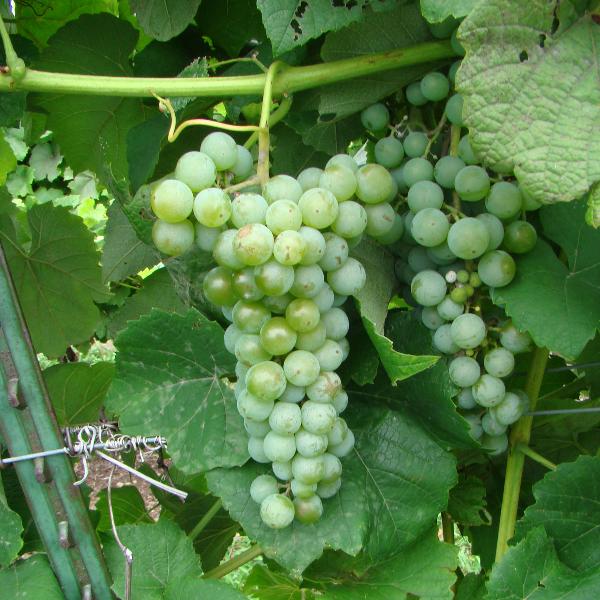Grapes fall into three general categories. European grapes (Vitis vinifera) are grown primarily in California, Texas, and Arizona; they are characterized by a thick skin adhering to a firm pulp and are sweet throughout. Muscadine grapes (Vitis rotundifolia) are grown primarily in the South and are characterized by small bunches, relatively small fruits, a strong musky odor, and large seeds. Native American grapes (Vitis labrusca or Fox Grape and its hybrids with Vitis vinifera), are sometimes called slipskins; they have thin skin easily removed from the pulp which is somewhat acidic near the seeds. These grapes grow well in climates such as found around the Great Lakes and are the most suitable for our area. Weston Nurseries generally offers American grapes, to which the following information applies.
SPACING: 8’ on center in all directions. Support should be supplied. Grapes grow by means of tendrils which will cling to any support – trellis, arbor, or fence. For best production, they are usually grown on a wire trellis consisting of 2 wires attached to sturdy posts set 10’ apart. One wire should be about 30” above the ground with the second wire about 36” above the first.
REQUIREMENTS: Deep, highly organic, well drained, sandy or gravelly loam with a pH of 5.5-7.5; good air drainage in a site not subject to late winter frosts; and good full sun.
POLLINATION: The grapes we offer are all self-fruitful. There are some Muscadines that are not.
PLANTING: The grapes we sell are container grown. Dig the hole 12-14” deep (slightly deeper than the root mass of the plant) and three times the diameter of the container. Amend backfill with rotted compost or peat moss. Because grapes like fairly sweet soil, add a handful of lime. Do not add any fertilizer except a small amount of superphosphate (0-20-0). Add backfill to the bottom of the hole and tamp. The final depth of the crown should be just slightly deeper than it grew in the container. Backfill, creating a “saucer” about 2’ in diameter to hold water. Mulch around the base, 3” deep but not touching the plant itself, to control weeds. Grapes are susceptible to damage from herbicides used in weed control; mulch is a safer method for control.
FERTILIZING: Each following spring, sprinkle a handful of lime and a handful of fertilizer (8-8-8 or 5-10-5) around the base of the plant. Grapes are susceptible to damage from overdoses of fertilizers.
WATERING: Apply enough water to wet the soil 18-36” deep whenever the soil 6-12” deep is almost dry.
PRUNING: Grapes are borne on the shoots that grow from buds on canes produced during the previous summer. An unpruned grape quickly becomes tangled and woody and will fruit poorly. It must be pruned every year to keep old wood to a minimum, to encourage new canes, and to maintain as neat a framework as possible. Prune in late winter or early spring (usually February or March). If pruning is done in late spring, the cuts will “bleed” excessively. Try never to prune when the vine is in leaf. There are many systems for pruning grapes. Many good books and the internet are valuable sources of information.
The most popular pruning method, the Four-Cane Kniffen System, trains the vine to a single stalk with a branch growing each way on two wires:
Year 1 — No trellis support is needed the first year. Select the strongest cane and tie it to a 5’ stake. Remove all other canes and pinch back the side shoots so that they have two leaves each.
Year 2 — Train the vine to a trellis consisting of 2 wires attached to sturdy posts set 10’ apart. One wire should be about 30” above the ground with the second wire about 36” above the first. Tie the cane to the top and bottom wire and cut the tip off 3” above the top wire. Remove all side canes.
Year 3 — Tie four laterals to the wires and prune them back to six buds each; these produce the current year’s fruit. Prune another four adjacent laterals to two buds each; these will produce next year’s fruit. Remove all other canes.
Year 4 — Cut away the canes which bore fruit the previous year. Tie up the canes which the previous year were cut back to two buds; these will produce fruit for the current year. Prune another four adjacent laterals to two buds each; these will produce fruit for the next year. Repeat this step to produce 4 new canes each of the following years.
DISEASES AND PESTS: The better maintained the quality of the foliage, the better the quality of the fruit will be. An all-purpose orchard spray, which combines controls for both insects and diseases in a single product, is highly recommended. Follow the manufacturer’s directions carefully. During the growing season, any shriveled fruit or canes should be removed; use clean pruners disinfected between each cut (dipped in ½ c. bleach to 1 gal. water). Destroy all diseased. Fall clean-up of all fallen leaves and fruits will help prevent any disease and insect problems the following year.
HARVESTING: Protect grapes from birds by placing netting over the trellis, covering the plants to the ground, about two weeks before harvest. Pick from mid to late August through September. For dessert or wine or juice, wait until grapes are quite ripe before picking. For jelly, pick about one week before ripe; grapes then have a higher pectin content and make a much clearer jelly. The varieties below are characterized as early, midseason, or late.
SEEDLESS TABLE GRAPES:
Canadice Early. One of the hardiest red seedless. Sweet medium size fruit in compact clusters.
Concord Seedless Early midseason. Similar in texture and flavor to Concord, although unrelated, with smaller clusters and berries, earlier. Excellent for pies and preserves. Can produce seeds in warm years.
Himrod Earliest white. Excellent quality. Hardier than Interlaken.
Interlaken Very early. White with smaller fruit size than Himrod.
Lakemont Late. White. Similar to Himrod and Interlaken with better disease resistance. Vigorous.
Mars (PP5680) Early. Round blue fruit with strong flavor. Very hardy, vigorous. Slipskin. Production should be controlled on young vines to prevent delays in establishment. Same as Mars Seedless.
Reliance Midseason. Very tender, sweet, pink. One of the hardiest.
OTHER TABLE GRAPES:
Concord Midseason. Blue-black grape for dessert, processing, or wine. Reliable producer.
Seneca Midseason. Top quality white dessert.
WINE GRAPES:
Aurora Very early. Pink.
Catawba Late. Red. Primarily used for wines and champagnes but also excellent for juices, jams, and jellies.
Cayuga White Late. Resembles white Riesling. Disease resistant. Extremely vigorous.
Niagara Midseason. Best quality white. Also acceptable dessert grape.
White Diamond Early midseason. Mild, sweet. Easy to train to cordons.








